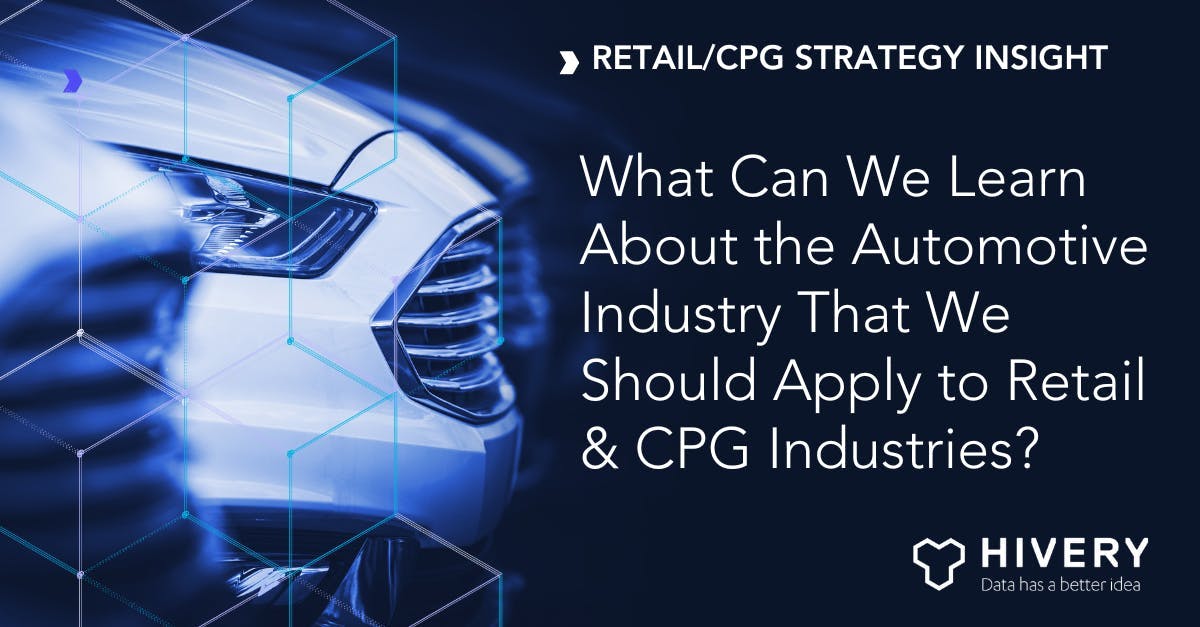
What Can We Learn About the Automotive Industry That We Should Apply to Retail and CPG Industries?
Did you know that experts believe that up to 15 percent of cars sold in 2030 could be fully autonomous? The automotive industry is constantly evolving. But what does this have to do with retail and CPG?
Automotive and retail are not two industries that have much in common. But surprisingly, a lot can be learned from the automotive industry that can be applied to other industries, such as retail and CPG (consumer packaged goods).
Keep reading, and we will look at what insights retail and CPG companies can gain from the automotive industry.
Parallels Between the Automotive Industry and Retail/CPG
There are several parallels between the automotive industry and retail/CPG.
Both industries are highly competitive, with companies constantly trying to one-up each other to leverage consumer insights to design and drive better offerings. Both industries rely heavily on effective supply chains, as disruptions can majorly impact the bottom line.
In addition, both industries face challenges when it comes to innovation. In the automotive industry, companies are constantly trying to develop new technologies to make cars more fuel efficient, safer, and more comfortable to drive. In the retail/ CPG industry, we always look for product innovation and try to distribute these products optimally, in the right store, and in the right stocks.
The significance of product innovation & simulation in the automotive industry
In recent years, there has been a shift in the automotive industry towards data-driven decision-making. This is partly due to the growing availability of data and advancements in analytical tools and techniques.
As the automotive industry becomes more competitive, data and analytics will play an even more important role in helping companies gain a competitive edge. Those who can utilize data effectively will be better positioned to improve their products, reach new markets, and drive growth.
In fact, Mercedes Benz plans to have its vehicle fleet carbon-neutral by 2039 with electric vehicle innovation as a priority; for that to happen, they need to focus on next-generation battery technology. The challenge with battery technology is that it is a mystery. While they know how to "make batteries," they do not know what's happening inside the battery while it's working. A battery is a complex ecosystem, and there is no technology or supercomputer currently that can accurately simulate what is happening inside a battery when the chemical reactions occur to improve storage capacity and ensure vehicles can go longer with less recharging.
To understand how a battery works, Mercedes Benz scientists need to go to the molecular level and see the electrons are interacting. To accurately simulate electron interactions at this level and understand the chemical reactions taking place takes days, even on the most powerful supercomputer on the planet. Even when they get the results of the chemical reactions, it's approximate using classical computing and algorithms. These existing approaches take longer, and scientists get an "average of averages" approach to molecular reactions. Further, the team makes many assumptions along the way. This means the process is laborious, with much trial and error. In reality, such a task would take decades to complete.
Mercedes Benz needs a new way to think about the problem and has turned to quantum computing to explore how we can more accurately simulate the chemical reactions in batteries. Using quantum computing and new advanced algorithms, Mercedes Benz can rapidly simulate and design new materials to create more efficient batteries. Ford and BMW are also using new technologies and methods to find better ways for electric vehicle (EV) batteries, including computational chemistry simulation software.
The significance of product innovation & simulation in retail and CPG
The automotive industry is using new computing methods and algorithms to "simulate" the properties of new materials that might make batteries safer, more energy-dense, and easier to recycle. Simulating the actual behavior of a battery could unlock new discoveries, product innovation, and opportunities for consumers and the automotive industry. Simulating offers the industry a new way to solve problems we previously couldn't tackle.
The retail and CPG industries have the opportunity to do the same; instead of simulating better EV battery materials, we're simulating different assortment and category strategies.
Like the automotive industry, which has taken the averages-of-average approach in understanding the reactions in a battery at the molecular level, retail and CPG industries have the ability to leverage data at the store level to gain precision insights and test different assortment and category strategies. With artificial intelligence (AI) and new algorithmic methods in machine learning, we can simulate different scenarios, qualify the impact on those strategic scenarios and execute the preferred strategy with auto-generated planograms.
AI can simulate and qualify strategic questions like What are the best stores to sell our innovative items but not impact our core brands? Is the value of having localized assortments for each store? What stores need more POS promotions to support the sales of my product innovation? How can I optimize my days of supply strategy of my new innovation to reduce out-of-stock and meet the local demands of each store?
Improve Retail and CPG Experience with the Right Tools
While the automotive and retail/CPG industries are different, they can learn much from each other. Leveraging new methods and computing power is imperative for success. HIVERY Curate offers this opportunity to look at shopper insights from the store level, run different strategies, qualify the impact of each strategy and generate planograms to execute the best strategy in those stores.
If you like to learn more or see a demo, contact us
Related resources you might be interested in:
Industry Insight: Assortment strategies that generate smarter planograms with few resources
Guide: Enabling Retail Space Planning With AI
Guide: Retail Store Cluster Strategies: Leveraging AI Towards Locally Relevant Shelves